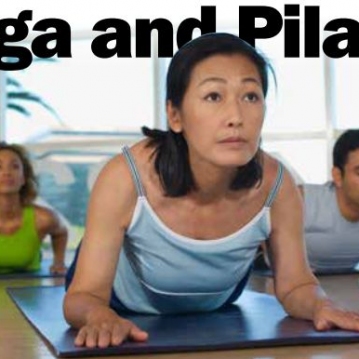
Back pain can occur for many reasons: herniated disks, spine misalignment, sacroiliac joint problems, etc. People suffering from these conditions often seek out specific types of exercise such as Pilates and Yoga.
The spine is composed of 24 vertebrae. The pelvis contains the sacrum, composed of five fused bones, and the coccyx, composed of four bones fully or partially fused. The sacrum meets the spine at the sacroiliac or SI joint. The central nervous system, CNS, travels from the brain through the central opening in each vertebra, with peripheral nerves branching out into the body through the lateral spinal openings. Intervertebral disks, IVDs, are located between each vertebra.
Herniated disks are often a cause of back pain. An IVD absorbs compression by transferring it across itself. However, the nucleus is composed of 70-90% water, which is incompressible, so overloading the spine can push nuclear material outward irritating the nerves in that area. A herniation occurs when the nucleus pushes out past its encapsulating coating.
Pilates can lessen back pain. It focuses primarily on strengthening the core, correct alignment, and stabilizing the pelvis and the spine while moving the limbs, all skills which tend to reduce pain in people with herniation. Yoga can also be very helpful for this condition, but its very nature of creating movement and opening requires extra attention during movement. The isolating work of Pilates may be a safer a way to begin exercising with progression to Yoga when ready.
Pain may also be localized in the lumbar spine. Depending on the cause, a Yoga practice can be beneficial by loosening up the muscles of the lower back and stretching the hamstrings which contribute to low back pain. However, if the pain was caused by incorrectly twisting, side or forward bending, these movements should be avoided. In this case stabilization work is recommended again in addition to teaching the individual how to properly elongate and move the spine.
SI joint misalignment can also cause back pain. Due to the positioning of the composing parts of the pelvis, weight bearing forces run obliquely through the joint causing strange pain referral patterns in places such as buttock, low back, groin, lower extremity, knee pain and foot pain. SI joint malfunction is usually caused by pelvic torsion, such as when doing unilateral leg work. SI joint is also vulnerable to age-related changes and should be diagnosed correctly. Activation of the transversus abdominis was found to have the greatest effect on increasing SI joint stability. Exercise protocols which focus on the strengthening of these muscles by precise contractions and stretches which focus on the hamstrings and hips are necessary to acquire and maintain healthy lumbarpelvic alignment and a neutral spine.
Yoga is rich in hamstring and hip stretches. However, care must be applied since there are many postures which are performed on one leg or put more weight on one leg than the other, potentially aggravating the SI joint. Assuming mindful movement, the Yoga practice can and does help when performed properly. Pilates is of course famous for its activation of the transversus abdominis. It is the foundation of the entire practice. Therefore, Pilates is strongly recommended.
Pain also occurs in a misshapen spine.
Scoliosis, for example, describes a spine which has one or more curves when viewed from the back. This happens due to an abnormal rotation in the vertebrae, creating a twisting of the spine; a side bend may also be present. A body with this condition may display a ribcage which is more prominent on one side, off center positioning of the head, uneven shoulders or hips, a leaning body, and even difficulty breathing and fatigue.
Again, Yoga is beneficial here.
Knowledge and training becomes especially important when trying to improve pain that stems from scoliosis. But if the instructor understands how to work with the spine, Yoga can be a way to feel lighter and longer in the spine. A Yoga session would be enhanced if followed by the slow, stabilizing, elongating and strengthening exercises of Pilates. Most Pilates exercises emphasize and aim to strengthen the neutral shape of the spine.
Other methods need to be employed when the condition is serious enough be unresponsive to exercise alone.
Larisa Klein • Wellness Achieved Studios • 3000 E Commercial Blvd., Ft. Lauderdale, Fl. 33308 • www.wellnessachieved.com • 954-600-9828 Larisa has been training in Yoga, Pilates, and functional weight training for 20 years since. 1997. She has extensive experience working with cancer survivors, people with various physical special conditions (joint/spinal injuries/operations/replacements/MS/etc.), internal special conditions (schizophrenia, drug/alcohol addictions) as well as triatheletes and Olympians. She is a black belt with full competition experience, a current practitioner of Kung Fu, and has an MA in Mathematics and a second BS in Alternative Medicine.






















